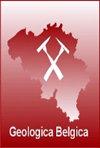穆斯蒂地层(比利时布拉班特山丘):最新研究成果
IF 0.7
4区 地球科学
Q2 GEOLOGY
引用次数: 0
摘要
穆斯蒂地层具有独特而特别有趣的岩石学、矿物学、沉积学、变质学和构造学特征,这些特征一直是与瓦隆新地质图有关的大量研究的主题,同时也是大量学术研究的主题,这些研究有时尚未发表。因此,有必要在更新的框架内对其进行综合和升级。在介绍了其定义、测绘和露头区域的历史之后,将陆续详细讨论以下主题,并配有图表和照片:其岩相地层学(可能在 Court-St-Etienne 反斜线附近发现了其基底)、其严谨的生物地层学和年代地层学、对其最小厚度的新估计、其沉积学--迄今为止很少涉及的主题--以及由此产生的沉积环境。除了锰含量异常高和钙含量极低之外,它的地球化学与黑页岩国际标准相当;建筑物中的高氡含量与露头黑板岩有关。其矿物学中含有丰富的含锰变质矿物,其变质作用超越了严格的地层框架,涉及整个布拉班特山丘的南部露头边缘。最后,我们结合更多的野外数据,以创新和统一的低角度延伸剥离概念--阿斯昆蓬剥离系统--为背景,讨论了穆斯蒂地层与构造之间的关系。所有这些观察结果,有些是旧的,有些是最新的,都在布拉班特喀里多尼亚基底地质学以及全球地层学和下古生代古地理学的最新框架内进行了讨论,使我们得以重新深入了解穆斯蒂地层及其在布拉班特山丘中的地位。本文章由计算机程序翻译,如有差异,请以英文原文为准。
The Mousty Formation (Brabant Massif, Belgium): state of the art
The Mousty Formation has unique and particularly interesting lithological, mineralogical, sedimentological, metamorphic and tectonic characteristics which have been the subject of much research in connection with the new geological map of Wallonia, but also within the framework of a large amount of academic research, sometimes unpublished. An effort to synthesise and upgrade it in an updated framework seemed necessary. After a history of its definition, mapping and outcrop areas, the following topics are successively addressed in detail and illustrated with diagrams and photos: its lithostratigraphy with the probable discovery of its base near the Court-St-Etienne anticline, its well-constrained biostratigraphy and chronostratigraphy, a new estimate of its minimum thickness, its sedimentology—a subject little addressed until now—, and the resulting depositional sedimentary environment. Its geochemistry, never addressed, is comparable to black shale international standards, except for abnormally high manganese and very low calcium contents; high radon levels in buildings are related to the black slate presence in outcrops. Its mineralogy is rich in manganese-bearing metamorphic minerals, its metamorphism in which we go beyond the strict framework of the formation to deal with the entire southern outcropping rim of the Brabant Massif. Finally, the relationship between the Mousty Formation and the tectonic is discussed, with additional field data, in the context of the innovative and unifying concept of a low-angle extensional detachment called the Asquempont Detachment System. All these observations, some old and some very recent, discussed in the updated framework of the geology of the Caledonian basement of Brabant and in the global stratigraphy and palaeogeography of the lower Palaeozoic, allow us to renew in depth the vision we had of the Mousty Formation and of its place in the Brabant Massif.
求助全文
通过发布文献求助,成功后即可免费获取论文全文。
去求助
来源期刊

Geologica Belgica
地学-地质学
CiteScore
4.70
自引率
27.80%
发文量
8
审稿时长
>12 weeks
期刊介绍:
Geologica Belgica is a Belgian journal that welcomes papers concerning all aspects of the earth sciences, with a particular emphasis on the regional geology of Belgium, North West Europe and central Africa. Papers not dedicated to the geology of Belgium, North West Europe and central Africa are only accepted when one of the authors is linked to a Belgian University or Institution. Thematic issues are highly appreciated. In this case, guest editors take in charge the selection of the manuscripts and the subject of the papers can be enlarged. The journal is in open access.
Submitted manuscripts should be concise, presenting material not previously published. The journal also encourages the publication of papers from Belgian junior authors. Short letters are accepted. Papers written in English are preferred. Each mansucript will be reviewed by at least two reviewers.
 求助内容:
求助内容: 应助结果提醒方式:
应助结果提醒方式:


